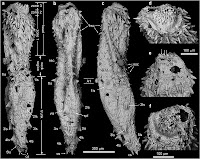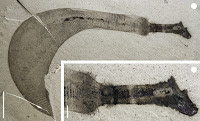Kinorhynchs are tiny (generally less than 1 mm) worm like animals found in marine sediments. They appear to be ubiquitous members of the interstitial meiofuana (animals that live between sediment grains) in shallow marine habitats, but have been studied in relatively few locations. Kinorhynchs are thought to be related to Pripulid Worms (large unsegmented
Worms with evertable pharyxes and Loriciferas (small unsegmented
animals with cup-shaped rigid bodies and evertable pharynxes), and like these groups have evertable pharynxes, which is used not just in feeding, but in locomotion, being pushed ahead of the animal then anchored and used to pull it forwards.
In a paper published in the Raffles Bulletin of Zoology on 29 January 2016, Martin Sørensen, Ludwik Gąsiorowski and Phillip Randsø of the Section for GeoGenetics at the Natural History Museum of Denmark, Nuria Sánchez of the Department of Zoology and Anthropology at the Universidad Complutense de Madrid and Ricardo Neves of the Biozentrum of the University of Basel, describe three new species of Kinorhynches from Singapore, as part of a study of this group around the island; Kinorhynches have previously been recorded but not identified from the Malaysian Peninsula, while elsewhere in Asia the specimens have been identified from Borneo, Indian territories around the Bay of Bengal and Anderman Sea, and the coasts of Japan, Korea, China and the Russian Far East.
The first new species is placed in the genus Centroderes, which has previously been described from the Black Sea, the Mediterranean, the Caribean and the Atlantic Coast of North America, and given the specific name 'impurus' meaning 'unclean' or 'covered with dirt' in reference to the sediment which covered the specimens and which made examination of them very difficult.
The species is described from two stage 2 adult males and four specimens of indeterminate sex that are either stage 6 juveniles or stage 1 adults (Kinorhynches have eight growth stages, the first six considered to be juvenile stages and the final two adult, though sexual characteristics are only manifest in the final stage), collected at a depth of nine meters between Bedok Jetty and Sungei Bedok in the southeast part of Singapore Island.
The second species described is placed in the genus Echinoderes, and given the specific name annae, after Anna, the girlfriend of Phillip Randsø. The species is described from two males, two females and a juvenile collected from muddy Seagrass aggregations on the intertidal zone on Saringat Island, a small Singapore terretory to the south of the main island.
The final species described is placed in the genus Leiocanthus. and given the specific name nagini, which is the female version of Nāgá, a Sanskrit word implying a devine Serpent or Dragon, as well as being the name of Voldemort's Snake in JK Rowling's Harry Potter novels. The species is described from a single male collected from a depth of 52 m to the southeast of Singapore island, and a female collected at a depth of nine meters between Bedok Jetty and Sungei Bedok in the southeast part of Singapore Island.
In addition to the new species described, Sørensen et al. also record several previously described species from Singaporean waters for the first time, notably Condyloderes paradoxus, a species previously recorded from the Bay if Bengal, Echinoderes tchefouensis, a species widespread in East Asia, and two unidentified species of Echinoderes.
See also...
 Scathascolex minor: A Palaeoscolecid Worm from the Middle Cambrian Burgess Shale of British Colombia. Palaeoscolecids are a group of vermiform animals (worms) known from
Cambrian to Silurian deposits. They had rings similar to...
Scathascolex minor: A Palaeoscolecid Worm from the Middle Cambrian Burgess Shale of British Colombia. Palaeoscolecids are a group of vermiform animals (worms) known from
Cambrian to Silurian deposits. They had rings similar to...
 Eokinorhynchus rarus: A Kinorhynch from the Early Cambrian of Sichuan Province, China. Kinorhynches are tiny (at most 3 mm) worm like
animals found in marine sediments, with segmented tube- or
barrel-shaped bodies, separate head and neck regions and evertable
pharynxes. They are related...
Eokinorhynchus rarus: A Kinorhynch from the Early Cambrian of Sichuan Province, China. Kinorhynches are tiny (at most 3 mm) worm like
animals found in marine sediments, with segmented tube- or
barrel-shaped bodies, separate head and neck regions and evertable
pharynxes. They are related...
 Priapulid Worms from the Middle Cambrian of Canada. Priapulid Worms are a form of marine worms with denticle-covered
pharynxes which can be everted to form proboscises. They are a minor element of..
Priapulid Worms from the Middle Cambrian of Canada. Priapulid Worms are a form of marine worms with denticle-covered
pharynxes which can be everted to form proboscises. They are a minor element of..
Follow Sciency Thoughts on Facebook.
Light micrographs showing lateral overviews of Centroderes impurus. (A) Adult male stage-2. (B) Putative J6 or adult stage-1 specimen of unknown gender. Sørensen et al. (2016).
The species is described from two stage 2 adult males and four specimens of indeterminate sex that are either stage 6 juveniles or stage 1 adults (Kinorhynches have eight growth stages, the first six considered to be juvenile stages and the final two adult, though sexual characteristics are only manifest in the final stage), collected at a depth of nine meters between Bedok Jetty and Sungei Bedok in the southeast part of Singapore Island.
Line art illustration of Centroderes impurus, male stage-2, lateral view. Abbreviations: ij, intersegmentary joint line; lass, lateral accessory sensory spot; ldss, laterodorsal sensory spot; ltas, lateral terminal accessory spine; lts, lateral terminal spine; lv, lateroventral spine; mdp, middorsal placid; mds, middorsal spine; mls, midlateral spine; mlss, midlateral sensory spot; mts, midterminal spine; mvp, midventral process; pdss, paradorsal sensory spot; pf, pectinate fringe; sdss, subdorsal sensory spot; sf, secondary fringe; vms, ventromedial spine; vmss, ventromedial sensory spot. Digits following labels refer to segment numbers. Sørensen et al. (2016).
The second species described is placed in the genus Echinoderes, and given the specific name annae, after Anna, the girlfriend of Phillip Randsø. The species is described from two males, two females and a juvenile collected from muddy Seagrass aggregations on the intertidal zone on Saringat Island, a small Singapore terretory to the south of the main island.
Light micrographs showing overviews and details of neck and trunk morphology in female and male specimes of Echinoderes annae. (A) Lateroventral overview. (B) Neck and segments 1–2, lateroventral view. (C) Neck and segments 1–2, laterodorsal view. (D) Segments 3–7, lateroventral view. (E) Segment 4, middorsal. F, segments 8–10, lateroventral view. (G) Segments 6–8, dorsal view. (H) Segments 10–11, dorsal view, showing male morphology. (I) Segment 11, ventral view, showing female morphology. (J) Segments 9, laterodorsal view. Abbreviations: gco1/2, glandular cell outlet type 1 or 2; ldt, laterodorsal tube; ltas, lateral terminal accessory spine; lts, lateral terminal spine; lvt, lateroventral tube; mds, middorsal spine; mlt, midlateral tube; mvp, midventral placid; pe1–3, penile spines; si, sieve plate; te, tergal extensions; trp, trichoscalid plate. Dashed circles mark glandular cell outlet type 1. Sørensen et al. (2016).
The final species described is placed in the genus Leiocanthus. and given the specific name nagini, which is the female version of Nāgá, a Sanskrit word implying a devine Serpent or Dragon, as well as being the name of Voldemort's Snake in JK Rowling's Harry Potter novels. The species is described from a single male collected from a depth of 52 m to the southeast of Singapore island, and a female collected at a depth of nine meters between Bedok Jetty and Sungei Bedok in the southeast part of Singapore Island.
Scanning electron micrographs of female Leiocanthus nagini in (A) ventrolateral overview, and (B) ventral overview. Sørensen et al. (2016).
In addition to the new species described, Sørensen et al. also record several previously described species from Singaporean waters for the first time, notably Condyloderes paradoxus, a species previously recorded from the Bay if Bengal, Echinoderes tchefouensis, a species widespread in East Asia, and two unidentified species of Echinoderes.
See also...
 Scathascolex minor: A Palaeoscolecid Worm from the Middle Cambrian Burgess Shale of British Colombia. Palaeoscolecids are a group of vermiform animals (worms) known from
Cambrian to Silurian deposits. They had rings similar to...
Scathascolex minor: A Palaeoscolecid Worm from the Middle Cambrian Burgess Shale of British Colombia. Palaeoscolecids are a group of vermiform animals (worms) known from
Cambrian to Silurian deposits. They had rings similar to... Eokinorhynchus rarus: A Kinorhynch from the Early Cambrian of Sichuan Province, China. Kinorhynches are tiny (at most 3 mm) worm like
animals found in marine sediments, with segmented tube- or
barrel-shaped bodies, separate head and neck regions and evertable
pharynxes. They are related...
Eokinorhynchus rarus: A Kinorhynch from the Early Cambrian of Sichuan Province, China. Kinorhynches are tiny (at most 3 mm) worm like
animals found in marine sediments, with segmented tube- or
barrel-shaped bodies, separate head and neck regions and evertable
pharynxes. They are related... Priapulid Worms from the Middle Cambrian of Canada. Priapulid Worms are a form of marine worms with denticle-covered
pharynxes which can be everted to form proboscises. They are a minor element of..
Priapulid Worms from the Middle Cambrian of Canada. Priapulid Worms are a form of marine worms with denticle-covered
pharynxes which can be everted to form proboscises. They are a minor element of..Follow Sciency Thoughts on Facebook.




